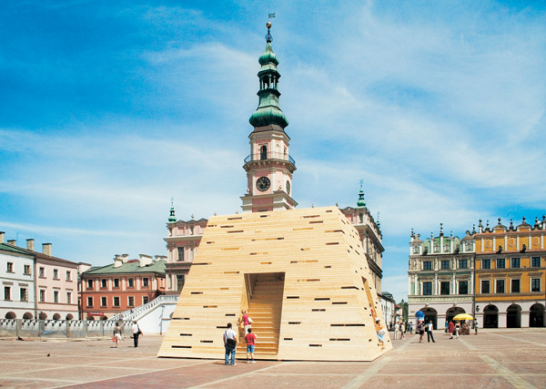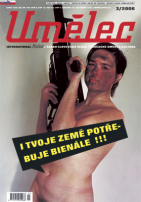| Umělec magazine 2006/3 >> The Ideal City is a Dead City | List of all editions. | ||||||||||||
|
|||||||||||||
The Ideal City is a Dead CityUmělec magazine 2006/301.03.2006 Anna Mituś | reviews | en cs de |
|||||||||||||
|
There has been a lot of talk about plentiful new international events of the biennial type. One can hardly imagine the global art scene without them, not to mention any self-respecting cultural center. The great curator and promoter of contemporary art, Anda Rottenberg, chose none of them for the location for such an event in Poland. The proving ground to establish it has instead become the eastern town of Zamość, founded in the 16th century as an ideal renaissance city, and the first of the exhibition series shall constitute one the international Art Forum Berlin show.
“I was paid to go here” is a sign whose wording undulates contemplatively on the bag of Sebastian Cichocki, the artistic director of the Bytom Kronika gallery. I am trying to keep up with him by forcing my way through the red and white entanglements of the narrow streets of Zamość. J- explains about the never-ending renovation work on the pavement of the main marketplace and streets; it primarily involves the turning over of the cobblestones. “Polnische Wirtschaft” is what the Germans would say, but this time we are all on the same boat. The opening of Ideal City – Invisible Cities, a grand international exhibition whose curators are Sabrina van der Ley (who has been managing the Art Forum Berlin since 2000) and Markus Richter, is to take place in two hours. The curators do not have the time to answer my questions (the press conference ended an hour ago). A well–organized “guided tour” efficiently moves the group of invited critics among construction barricades that, judging by the looks of concentration, many clearly suspect are a part of the exposition concept. A representative of the local community stops me on the marketplace. Leaning on a dilapidated bicycle, he asks about the “meaning of the structure blocking the view of the town hall.” “It’s a pyramid. It was built by Colin Ardley,” I answer, but my interlocutor does not give up so easily. “What’s it for?” Reporters from a German television station listen in on our conversation with interest. It is obvious that not many denizens of Zamość are confronted with thoughts on the question of the “ideal city” in their day–to–day lives. What in the golden age of the Renaissance was to have been the embodiment of humanism and tolerance is today a hicktown amidst the fields and forests of Roztocze, more reminiscent of Alfred Kubin’s City of Pearl than Sabbionetta in spite of its number in the UNESCO register. The impression created by a group of approximately forty artists from throughout the world, weaving about the dingy architecture amidst burghers' houses with fallen plasterwork, sweating in the 30 degree [86°F] continental heat is truly astounding. It seems like the landing of a civilizing mission by “Star Trek’s” U.S.S. Enterprise whose crew members “boldly go where no man has gone before.” Equally bold are the beautiful installations of Colin Ardley and Teresa Murak presented on a scale unheard of in Poland, commenting and stressing the geometrical–spatial solutions of this Renaissance layout. By joining together the center of urban space in a symbolic vertical and horizontal structure, they affirm the order–making utopia of the human universe. Just beyond the corner is an ironic comment that adds a paraphrase of Tatlin’s Monument to the Third International built of pine boards on the Salt Market by Kaia Schiemenz. Ignoring the dangerous cracking of unseasoned boards and the “at your own risk” notice, a band of speeding youths subjugate the dynamic twists of this Commintern Tower of Babel. One comes across two completely different monuments to disorientation behind the first row of marketplace structures. The inner courtyard of one of the tenement houses is filled by the yielding labyrinth of Franka Hoernschneider; its wall–doors give way to the free choice of direction of travel. The title Konditional demonstrates the active nature of space and thus offers therapy for the depression of the Eastern Minotaur. Monika Sosnowska uses a fully credible form of the concrete “white Marianne” – like a cult Polish TV series – in building a provocative and nightmarish fountain of cubes. Anyone who has ever walked across a housing estate from the Gierek era has to be subdued by the illusion that the sculpture has always stood on the square and even the disgust caused by the black water bubbling in the rectangular pool has no easy job of wrenching viewers out of their stupor. Invisible Cities: What the Eye Fails To See … The taste of the curators created an exceptionally beautiful, minimalist exhibition design. The grid structure of the ideal city is in agreement with the cool, intellectually geometricized and disciplined aesthetic of the works they selected. The formal similarity is intriguing in the way in which it blurs the differences between the motivation behind individual works, turning attention away from their interpretation. All the more shocking is the “Radetzky March” screeching from the interior of a rather abstract wall–like structure the color of concrete. The sounds are blurted out with renewed impetus whenever some loving couple emerges from the park onto the green around the fortifications with the intention of using the sidewalk near the Lublin Gate. A moment later I identify the puzzling structure with the help of Anda Rottenberg, one of the commissioners of the exhibit. Designed by Mirosław Bałka, it is a 1:1 scale model of the kitchen wall of Auschwitz, where an orchestra of prisoners greeted those coming to the camp in successive transports. However, the surprise quickly gives way to a typical Polish (loaded with German–gobbling incorrectness) complaining: An installation that just had to be present in an exhibit devoted to utopia, especially one under the auspices of Art Forum Berlin. The bulk of works represent an anti–utopian approach or one of the privatizing of utopia. It is difficult not to be swayed by the impression that the concept of the “ideal city” and the announced “praise of the matrix” is just a catchy pretext of the organizers for presenting a set of magnificent, albeit rather righteous works. The crisis of modern idealistic philosophy is connected with criticism of the Enlightenment (spatial analyses of minimal art, authoritarianism seen in the organizing of social life, and Auschwitz as the ideal city), while the mass conquests of successive social battles all the way to the harvests of the revolt of ’68 and the 1970s are subject to revision (Dan Graham, Tacita Dean, Jonas Dahlberg, Melani Smith, Jakob Kolding, Daniela Brahm, and Anton Vidokle). The current political dimension (the wall) is discretely introduced by artists from the Palestine (Rula Halwani and Tarek Al–Ghoussein). It is through the ateliers of planners and architects, that the enigmatic figure of Mikołaj Chrupkowski, like Ahasver, the Wandering Jew of international architecture, whose “ideal invisible museum” was built by Les Schliesser in the place of Zamość houses demolished some time ago, guides the audience. The fictitious architect, said to be from the home town of Rosa Luxemburg, whose image brings to mind a “people’s commissar,” and just like the Internet–fiction hero tourist–guy, is present on historical photographs of architects that, when juxtapositioned, disclose fictional revelation – the participation of Chrupkowski in the development of their designs. The paradox of utopia is brought into existence in an adequate phantom of ideal invisibility. Ten years ago, in describing the situation of incompatibility of the Western and Eastern European discourse on art, Hans Belting wrote: “Western culture, which claims for itself the idea of freedom and the presence on the market, now emerges as the universal heir of history, simply swallowing up the Eastern culture that was so much compromised. But can or should Western art simply be exported into the East, the same way Western currency was exported for the purpose of buying up the land and people east of the border?” (“East and West at the Watershed of Art History,” in Art History after Modernism, 54–61, p. 56). On the next page he explains the core of his fear as to the internal artistic recolonization of Europe: “Now, even in the East, art has to be ‘professional’ in that it is paid for, exhibited, and institutionalized” (p. 57). Has the art of the East achieved market maturity over the course of these ten years? Has the discourse of Eastern European art managed to gain any influence whatsoever on Western European moderno–centrism? It seems that progress in this integration process is rather on the side of an elegant colonization by Western institutions striving to counterbalance their own collapsing market. It is in this context of this velvet reconquista that the verses of Lawrence Weiner entwining the supports of a Zamość cloister carry a very penetrating sound: Found – after any given time due to its nature – after any given time due to proximity – after any given time mixed and matched – after any given time by chance – after any given time to make do with – after any given time wheresoever it is – after any given time
01.03.2006
Recommended articles
|
|||||||||||||











Comments
There are currently no comments.Add new comment